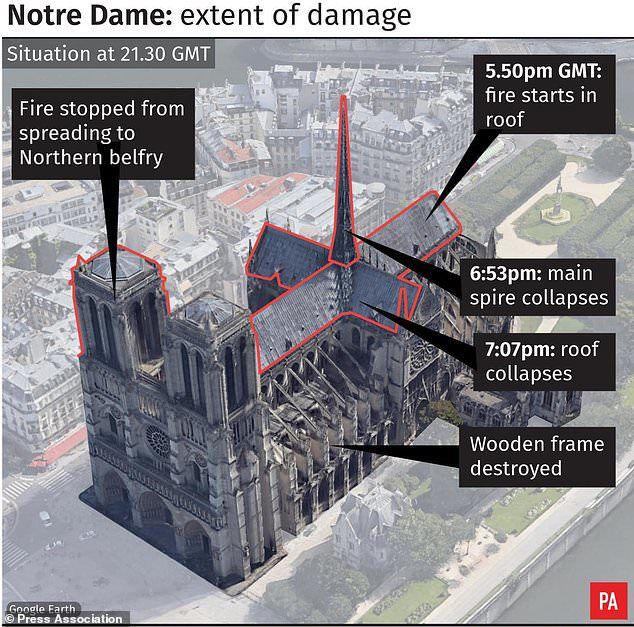The heart of Paris will beat again
April 16, 2019
Around 6 p.m. Monday, April 15 the Notre Dame Cathedral in Paris, France, was on fire. Officials consider the fire to be an accident relating to construction.
Before the fire started, the cathedral was working on renovations. Due to the renovations, many of the treasures of this historical building have been saved. Some of the relics that were saved during the fire include the Holy Crown of Thorns, the Great Organ, the tunic of Saint Louis, True Cross and Holy Nails, the Rose windows and Descent from the cross. Many of the artworks and sculptures were taken to the Paris town hall.
The Notre-Dame Cathedral has been the heart of Paris for over 800 years on Île de la Cité in the middle of Seine, France. The historical monument draws in about 13 million visitors per year, even more than the Eiffel Tower. The cathedral was built in 1163 during the reign of King Louis VII and was completed in 1345.
Tony Silvestri, history lecturer at Washburn University, discusses the significance of the cathedral.
“It’s been called the soul of France. It has so many centuries of history and that cathedral has stood and witnessed the coming and going of kings and armies, the French Revolution, the coronation of Napoleon, all of the revolutions of the 19thcentury. It withstood a bombing during World War II, Nazi occupation and liberation after World War II and it’s been the iconic symbol of the city of Paris before the Eiffel Tower was created,” said Silvestri.
With the 1831 novel, “The Hunchback of Notre Dame” by Victor Hugo, the interest and love for the cathedral was revitalized. After the novel re-popularized the cathedral, people began to notice and raise money for the cathedral.
Paul Mismaque, junior double major in marketing and economics, is an international student from Homblières, France. Homblières is about two hours from Paris.
“It’s a pretty big deal. I’m Catholic and it’s a big part of our education. Every time you go to Paris, you go there because it’s the most visited monument in Europe. Every time we have the pope that comes, he goes there because it is the biggest [cathedral] in France,” said Mismaque.
Silvestri explains that Notre-Dame Cathedral is also one of the earliest and possibly the greatest examples of Gothic architecture.
“It wasn’t the first Gothic building, but it was among the first great Gothic buildings. Students of architecture and art historians, medievalists and people who just love European culture, have been fascinated by that building and by its history. The vault is the ceiling that you see when look up from the inside and its made of stone. It was made in the Middle Ages and it’s almost all there. Two or maybe three portions of the vault collapsed and one of them was right in the center in the crossing where the spire was. That’s where the fire was greatest and so that whole area collapsed,” said Silvestri.
Four hundred firefighters, seven firetrucks and 15 hours later, the fire was extinguished.
“Paris has some of the best firefighters in the world. Nobody died, however one firefighter was injured. The spire of the cathedral was made of wood and lead. Some stories say the lead was actually raining and melting lead. One of the firefighters happened to be a priest and he ran through the melting Cathedral to get the crown,” Mismaque said.
After this catastrophic event, many people have come together to talk about rebuilding the cathedral. Several people and organizations have already donated millions of dollars to rebuild it.
“President Macron came out publicly and said, ‘We’re going to do this and we’re going to do it in five years, and it will be better than it was before.’ He has to say that as the leader of the French people, and I think they’ll come together,” said Silvestri.
Mismaque explains that the president is also planning to establish a national subscription or government website for donations.
The Notre Dame Cathedral is one of the many designated UNESCO world heritage sites and have received a lot of support from them during this time. In one of their recent Twitter posts, UNESCO states that they are ready to make their expertise available to authorities, contribute to a rapid damage assessment and support the reconstruction and rehabilitation of Notre Dame Cathedral.
“The damage was significant and it was catastrophic, but as damage to a medieval cathedral goes, this wasn’t a very serious thing. Most of the precious stuff was all saved. Most of the interior is intact and so on. So the kind of doomsdayers, that are like, ‘Oh, poor Notre Dame, it’s lost.’ No, it’s not. It’s not lost,” Silvestri said.



